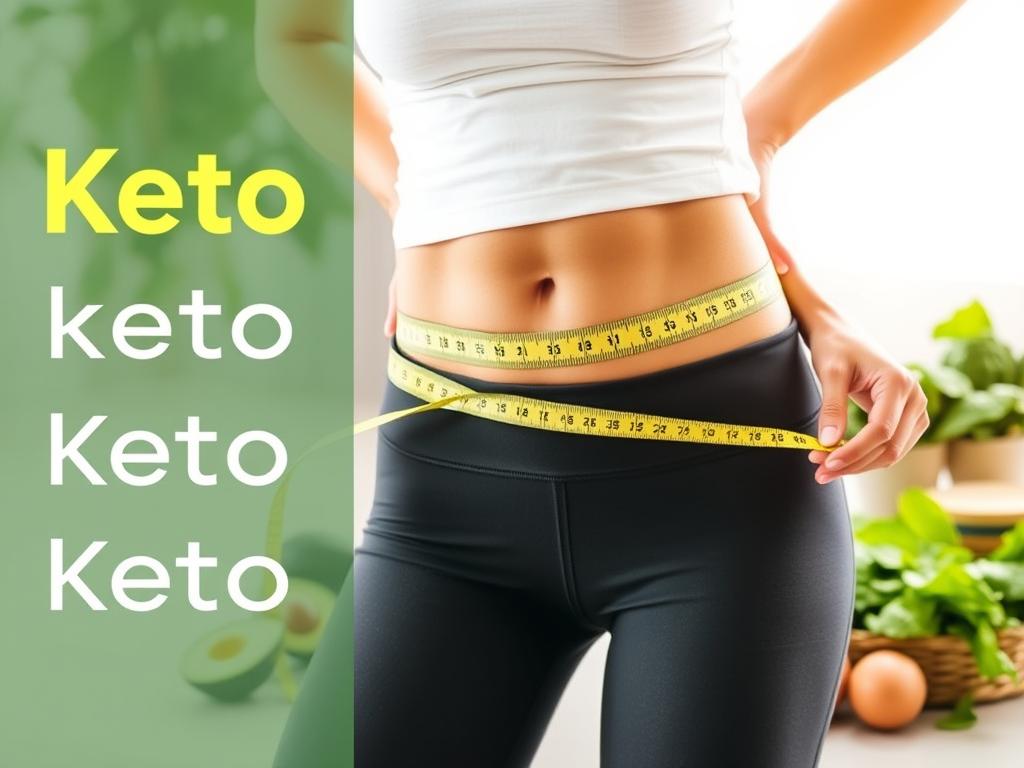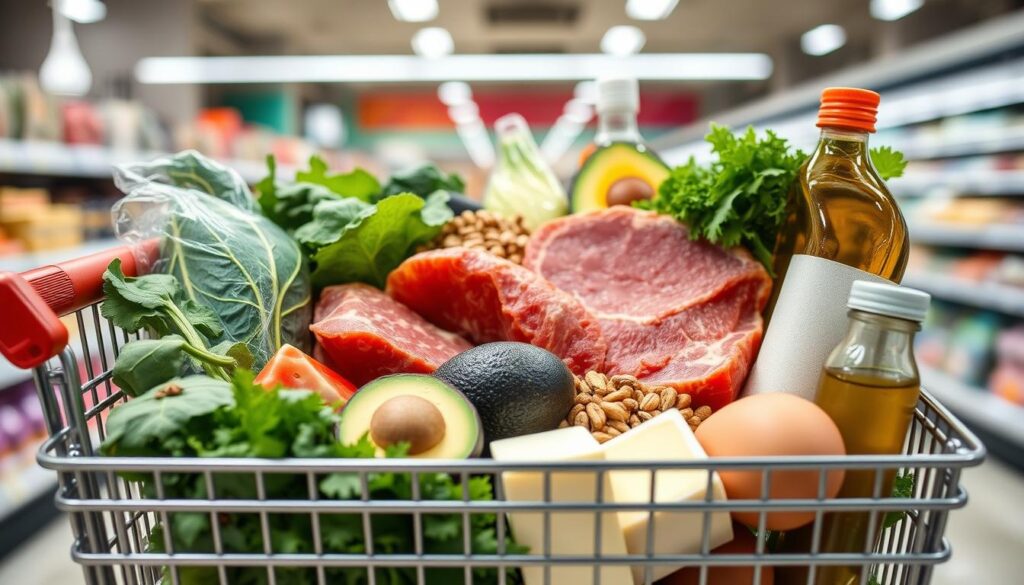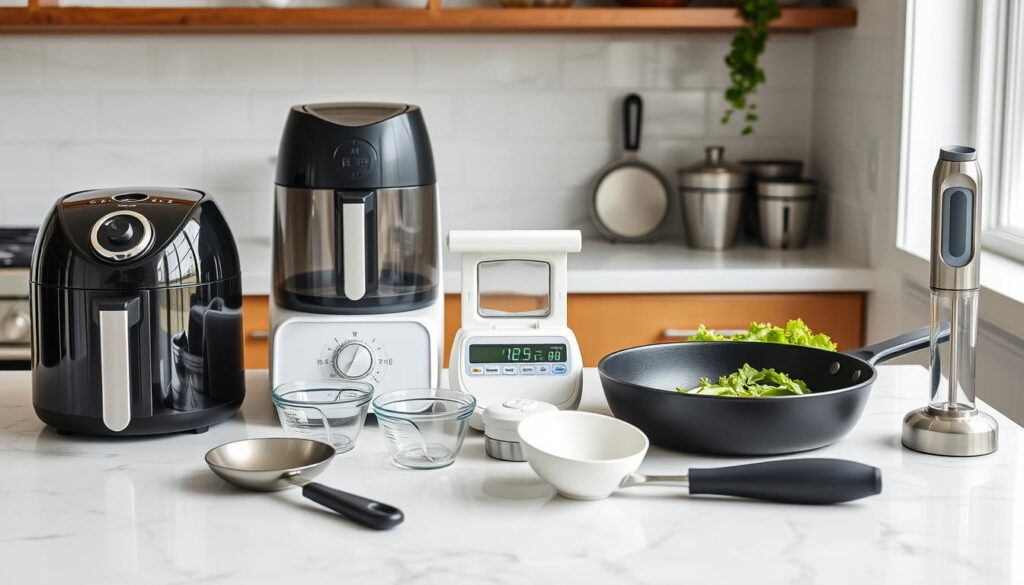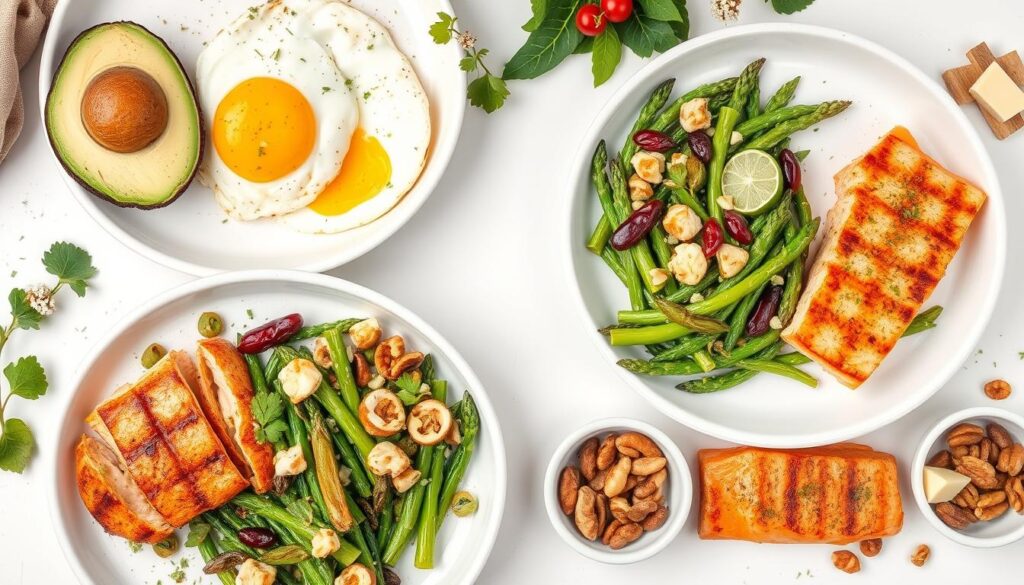Embarking on a ketogenic diet journey can transform your approach to nutrition and wellness. This low-carb, high-fat eating plan has gained popularity for its potential benefits in weight management, improved energy levels, and overall health enhancement. Whether you’re a complete beginner or looking to refine your keto knowledge, this comprehensive guide will walk you through everything you need to know to succeed on your keto lifestyle journey.
The beauty of the ketogenic diet lies in its simplicity once you understand the fundamentals. By making strategic food choices and equipping yourself with the right tools, you can make this powerful nutritional approach both enjoyable and sustainable. Let’s dive into the world of keto and discover how it can work for you.
What is the Ketogenic Diet?
The ketogenic diet focuses on high fat, moderate protein, and very low carbohydrate intake
The ketogenic diet is a low-carbohydrate, high-fat eating plan designed to shift your body’s primary fuel source from glucose (sugar) to ketones, which are produced when your body breaks down fat. This metabolic state, called ketosis, occurs when carbohydrate intake is drastically reduced, typically to under 50 grams per day.
When you limit carbs, your body depletes its glycogen stores and begins converting fat into ketones in the liver. These ketones then serve as an alternative energy source for your brain, muscles, and other tissues. This fundamental shift in metabolism is what makes the ketogenic diet unique compared to other nutritional approaches.
The Science Behind Ketosis
Ketosis is a natural metabolic state that humans evolved to enter during periods of food scarcity. By intentionally restricting carbohydrates, you can trigger this same survival mechanism. In ketosis, your body becomes incredibly efficient at burning fat for energy, which can lead to steady weight loss for many people.
Beyond weight management, research suggests the ketogenic diet may offer additional benefits, including improved blood sugar control, enhanced mental clarity, reduced inflammation, and more stable energy levels throughout the day.
Keto Macronutrient Breakdown
The standard ketogenic diet typically follows these macronutrient ratios:
- Fat: 70-75% of daily calories
- Protein: 20-25% of daily calories
- Carbohydrates: 5-10% of daily calories (usually 20-50 grams per day)
This high-fat, moderate-protein, and very low-carb approach is what distinguishes keto from other low-carb diets. The precise balance of these macronutrients is what allows your body to enter and maintain ketosis effectively.
Key Benefits of the Ketogenic Diet

The ketogenic diet offers numerous potential benefits that extend beyond weight management. While individual results may vary, many people report significant improvements in various aspects of their health when following a properly formulated keto plan.
Weight Management
One of the most common reasons people adopt a ketogenic diet is for weight loss. The diet naturally reduces appetite and food cravings by stabilizing blood sugar levels and increasing satiety hormones. Many find they can achieve sustainable weight loss without the constant hunger that accompanies traditional calorie-restricted diets.
Improved Energy Levels
Once your body adapts to using ketones for fuel, many people experience more consistent energy throughout the day. The elimination of blood sugar spikes and crashes can lead to improved focus, concentration, and steady energy levels.
Better Blood Sugar Control
By significantly reducing carbohydrate intake, the ketogenic diet naturally lowers blood glucose levels. This can be particularly beneficial for those with insulin resistance or type 2 diabetes, potentially improving insulin sensitivity and glycemic control.
Enhanced Mental Clarity
Many keto enthusiasts report improved cognitive function and mental clarity. Ketones are an efficient fuel source for the brain, and the stable blood sugar levels may contribute to better focus and concentration throughout the day.
The ketogenic diet isn’t just about weight loss—it’s a comprehensive approach to health that can positively impact energy levels, mental clarity, and metabolic health when implemented correctly.
Your Essential Keto Grocery List
Stocking your kitchen with keto-friendly foods is the first step toward success on this dietary approach. Here’s a comprehensive shopping list organized by category to help you get started.

A well-stocked keto kitchen starts with quality ingredients
Healthy Fats
Fats form the foundation of the ketogenic diet, providing both energy and flavor to your meals. Focus on incorporating a variety of healthy fat sources:
- Avocados and avocado oil – Rich in monounsaturated fats and potassium
- Olive oil – Perfect for salad dressings and low-heat cooking
- Coconut oil – Contains medium-chain triglycerides (MCTs) that support ketosis
- MCT oil – Premium MCT oil can be added to coffee or smoothies for an energy boost
- Butter and ghee – Grass-fed ghee is ideal for high-heat cooking and is lactose-free
- Nuts and seeds – Macadamias, almonds, walnuts, and chia seeds
- Nut butters – Sugar-free almond butter makes for a perfect keto-friendly snack
Quality Proteins
Moderate protein intake is essential on a ketogenic diet. Choose high-quality sources whenever possible:
- Eggs – Preferably pasture-raised for optimal nutrition
- Poultry – Chicken, turkey, and duck (with skin for extra fat)
- Beef – Grass-fed when possible for better fatty acid profile
- Seafood – Fatty fish like salmon, mackerel, and sardines
- Pork – Bacon, pork chops, and ham (uncured and sugar-free)
- Protein powder – Low-carb protein powder for convenient meal options
Low-Carb Vegetables
Vegetables provide essential nutrients and fiber while keeping carbs in check:
- Leafy greens – Spinach, kale, lettuce, and arugula
- Cruciferous vegetables – Broccoli, cauliflower, and Brussels sprouts
- Above-ground vegetables – Zucchini, asparagus, and bell peppers
- Herbs – Fresh herbs like basil, cilantro, and parsley
- Mushrooms – All varieties are generally low in carbs
- Onions and garlic – Use sparingly due to higher carb content
Dairy Products
Full-fat dairy can be included in moderation:
- Cheese – Hard cheeses like cheddar, gouda, and parmesan
- Cream – Heavy cream and cream cheese
- Yogurt – Full-fat Greek yogurt (unsweetened and in limited amounts)
Keto Pantry Staples
Stock these essentials for flavor and convenience:
- Sweeteners – Erythritol, stevia, or monk fruit sweetener
- Flours – Almond flour, coconut flour, and flaxseed meal
- Condiments – Sugar-free mayonnaise, mustard, and hot sauce
- Bone broth – Quality bone broth for soups and added nutrients
- Spices and herbs – Salt, pepper, garlic powder, and dried herbs
- Canned goods – Tuna, salmon, and coconut milk
Ready to Stock Your Keto Kitchen?
Having the right ingredients on hand makes sticking to your keto diet much easier. Get started with these keto essentials!
Essential Keto Cooking Tools

Having the right kitchen tools can make preparing keto meals significantly easier and more enjoyable. These essential items will help you create delicious low-carb dishes while saving time and effort.
Food Preparation Tools
- Food processor – Multi-function food processor for making cauliflower rice, nut flours, and keto doughs
- Spiralizer – Vegetable spiralizer for creating zucchini noodles and other veggie pasta alternatives
- Digital food scale – Essential for accurate portion control and recipe measurements
Cooking Equipment
- Cast iron skillet – Pre-seasoned cast iron pan for perfect searing and even cooking
- Air fryer – Multi-function air fryer for crispy foods without excess oil
- Slow cooker – Programmable slow cooker for tender meats and easy meal prep
Specialty Items
- Immersion blender – Hand blender for bulletproof coffee and creamy soups
- Silicone baking molds – Non-stick molds for fat bombs and keto desserts
- Smart scale – Body composition scale for tracking your progress on keto
Why These Tools Matter for Keto Success
The right kitchen equipment can significantly impact your keto journey in several ways:
- Time efficiency – Tools like food processors and air fryers speed up meal preparation
- Consistency – Digital scales ensure accurate macronutrient tracking
- Versatility – Create diverse meals to prevent diet fatigue
- Motivation – Track your progress with a smart scale to stay motivated
Investing in quality kitchen tools is investing in your health journey. The right equipment makes keto cooking more enjoyable and sustainable long-term.
Upgrade Your Keto Kitchen
Equip yourself with the tools that make keto cooking easier and more enjoyable. Your future self will thank you!
A Sample Keto Day: Making It Simple

A balanced day of keto meals providing optimal nutrition while maintaining ketosis
One of the best ways to understand the ketogenic diet is to see what a typical day of eating might look like. Here’s a sample meal plan that provides approximately 75% fat, 20% protein, and 5% carbohydrates.
Breakfast
Avocado and Egg Breakfast Bowl
- 2 eggs fried in grass-fed ghee
- ½ avocado, sliced
- 2 strips of sugar-free bacon
- Handful of spinach, sautéed
- Salt, pepper, and hot sauce to taste
Bulletproof Coffee (Optional)
- 8 oz freshly brewed coffee
- 1 tablespoon MCT oil
- 1 tablespoon grass-fed butter or ghee
- Blend until frothy
Macros: Approximately 30g fat, 20g protein, 4g net carbs
Lunch
Keto Cobb Salad
- 3 cups mixed greens
- 4 oz grilled chicken breast
- 1 hard-boiled egg, sliced
- 2 slices bacon, crumbled
- ¼ cup blue cheese crumbles
- ½ avocado, diced
- 2 tablespoons olive oil and vinegar dressing
Macros: Approximately 40g fat, 35g protein, 5g net carbs
Dinner
Baked Salmon with Asparagus
- 6 oz salmon fillet, baked with herbs
- 10 asparagus spears, roasted
- 2 tablespoons hollandaise sauce
- 1 tablespoon butter for cooking
- Lemon wedge and fresh herbs for garnish
Macros: Approximately 35g fat, 40g protein, 4g net carbs
Snacks (Choose One)
- 1 oz macadamia nuts with 1 oz cheese
- Celery sticks with 2 tablespoons almond butter
- ½ avocado with salt and lime juice
- 2 deviled eggs made with avocado oil mayonnaise
Macros: Approximately 15-20g fat, 5-10g protein, 2-4g net carbs
Hydration
Throughout the day, aim to drink:
- 8-10 glasses of water
- Herbal tea (unsweetened)
- Electrolyte supplements if needed, especially during the initial adaptation phase
Daily Totals: Approximately 120-130g fat, 100-105g protein, 15-17g net carbs
These macros are suitable for an average adult but may need adjustment based on your specific needs, activity level, and goals.
Meal Prep Tips
Make keto sustainable by preparing ahead:
- Batch cook proteins like chicken, ground beef, and hard-boiled eggs
- Pre-chop vegetables for quick salads and stir-fries
- Prepare fat bombs and keto snacks for busy days
- Keep frozen vegetables on hand for quick side dishes
Common Keto Challenges and Solutions

While the ketogenic diet offers many benefits, it’s not without its challenges. Understanding common obstacles and having strategies to overcome them can significantly improve your chances of long-term success.
Challenge: The Keto Flu
As your body adapts to using fat for fuel, you may experience temporary symptoms like fatigue, headaches, irritability, and brain fog.
Solutions:
- Increase sodium intake with bone broth or salt
- Stay well-hydrated and supplement with electrolytes
- Gradually reduce carbs rather than eliminating them suddenly
- Get plenty of rest during the adaptation phase
Challenge: Social Situations
Dining out, parties, and family gatherings can make staying keto difficult.
Solutions:
- Research restaurant menus in advance
- Eat a small keto meal before social events
- Offer to bring a keto-friendly dish to share
- Focus on protein and vegetable options
- Be prepared with keto snacks when traveling
Overcoming Cravings
Carb cravings are common, especially in the beginning:
- Keep keto-friendly snacks readily available
- Stay hydrated, as thirst is often mistaken for hunger
- Use keto-approved sweeteners in moderation for occasional treats
- Focus on fat-rich foods that promote satiety
Tracking Progress
Monitoring your journey helps maintain motivation:
- Use a smart scale to track weight and body composition changes
- Take measurements and progress photos
- Monitor energy levels, sleep quality, and mental clarity
- Consider tracking blood ketones if you want objective data
Remember that adaptation to a ketogenic lifestyle takes time. Be patient with yourself and focus on progress, not perfection.
Frequently Asked Questions About the Ketogenic Diet

How long does it take to enter ketosis?
Most people enter ketosis within 2-7 days of restricting carbohydrates to 20-50 grams per day. However, the time can vary based on your metabolism, activity level, and previous diet. Fasting can accelerate the process, while consuming too much protein or hidden carbs can delay it.
Will I lose muscle on a ketogenic diet?
Not necessarily. When following a well-formulated ketogenic diet with adequate protein (typically 0.6-1.0 grams per pound of lean body mass) and engaging in resistance training, most people can maintain or even build muscle. Ensuring sufficient protein intake and proper strength training is key to preserving lean mass while losing fat.
Can I exercise on keto?
Absolutely! Many people successfully exercise while following a ketogenic diet. There may be a temporary decrease in performance during the adaptation phase (2-6 weeks), but once fat-adapted, many report improved endurance and steady energy levels. For high-intensity activities, some people benefit from targeted carbohydrate intake around workouts.
Is the ketogenic diet safe long-term?
Research on long-term ketogenic diets is still emerging. Many people follow keto for years without issues, while others may do better cycling in and out of ketosis. A well-formulated ketogenic diet that includes a variety of nutrient-dense foods is generally considered safe for most healthy adults. However, it’s always advisable to work with healthcare providers, especially if you have existing health conditions.
What about cholesterol on keto?
Cholesterol responses to keto vary by individual. Many people see improvements in their lipid profiles, with increased HDL (good) cholesterol and decreased triglycerides. Some may experience an increase in LDL cholesterol. The quality of fats consumed matters—focus on healthy fats like avocados, olive oil, and nuts rather than processed fats. Regular monitoring with your healthcare provider is recommended.
Tracking Your Keto Journey
Monitoring your progress on the ketogenic diet can provide valuable insights and help maintain motivation. Here are effective ways to track your keto journey:
Physical Measurements
- Weight and body composition – A smart scale that measures body fat percentage can provide more comprehensive data than weight alone
- Body measurements – Track waist, hips, chest, arms, and thighs monthly
- Progress photos – Take photos in similar lighting and clothing every 2-4 weeks
Metabolic Markers
- Ketone levels – Blood, breath, or urine testing can confirm ketosis
- Blood glucose – Monitoring can be especially valuable for those with insulin resistance
- Blood pressure – Many experience improvements in blood pressure on keto
Subjective Measures
Don’t underestimate the importance of how you feel:
- Energy levels – Note changes in daily energy and endurance
- Mental clarity – Track focus, concentration, and cognitive function
- Sleep quality – Monitor sleep duration and how rested you feel
- Mood – Note changes in overall mood and emotional well-being
Track Your Progress with Precision
A quality smart scale is one of the best investments for your keto journey. Monitor weight, body fat, muscle mass, and more with accuracy.
Embracing Your Keto Lifestyle Journey

The ketogenic diet is more than just a way of eating—it’s a lifestyle approach that can transform your relationship with food and improve your overall well-being. By understanding the science behind keto, stocking your kitchen with the right foods and tools, and preparing for common challenges, you’re setting yourself up for success.
Remember that everyone’s keto journey is unique. What works for one person may need adjustment for another. Listen to your body, be patient during the adaptation phase, and celebrate your progress along the way. The benefits of improved energy, mental clarity, and metabolic health often extend far beyond weight loss.
Whether you’re just starting out or looking to refine your approach, the ketogenic lifestyle offers a sustainable path to better health when implemented thoughtfully. With the right knowledge, tools, and mindset, you can make keto work for your unique needs and goals.
The Zen Essentials
These items are the building blocks of a calm, intentional living space.
- Candles & Scents:
- Scented Candles: Look for calming, natural scents like sandalwood, lavender, white tea, or bergamot. Choose candles made with soy or beeswax for a clean burn.
- Essential Oil Diffusers: A minimalist, sleek diffuser made of bamboo, ceramic, or glass.
- Essential Oil Sets: Look for blends specifically for relaxation, focus, or sleep.
- Incense & Burners: Natural incense sticks (e.g., palo santo, sage) with a simple, elegant burner.
The Zen Decor
This is about incorporating natural elements and simple design.
- Natural Materials:
- Wood or Bamboo Trays: For organizing candles, stones, or other small items.
- Ceramic Vases: Simple, unglazed ceramic vases in neutral colors like white, beige, or gray.
- Minimalist Art: Simple line drawings, abstract prints, or nature-inspired artwork.
- Hand-Carved Stone Coasters: Or other small stone sculptures.
- Textiles:
- Linen or Cotton Throws: A soft, neutral-colored throw blanket to add warmth.
- Jute or Sisal Rugs: These add natural texture and grounding to a space.
- Meditation Cushions (Zafu) & Mats (Zabuton): These provide comfort for meditation and add a serene touch to a room.
The Zen Ambiance
These items help create a peaceful sensory experience.
- Lighting:
- Himalayan Salt Lamps: These provide a warm, soft glow.
- Japanese-style Paper Lanterns: For a soft, diffused light source.
- Dimmable Smart Bulbs: To easily control the warmth and brightness of your lighting.
- Sound:
- Tabletop Water Fountains: The gentle sound of running water is incredibly calming.
- Wind Chimes: Made from natural materials like bamboo or metal for a soft sound.
- Bluetooth Speakers: Small, aesthetically pleasing speakers for playing ambient or meditation music.
- Nature:
- Bonsai Trees or Air Plants: Low-maintenance indoor plants that bring life and a touch of nature indoors.
- Zen Gardens: A small, tabletop sand garden with a rake and stones for a meditative ritual.
- Decorative Rocks & Pebbles: For bowls or as a decorative element.
Best Sellers https://amzn.to/3Vet1tI
New Releases https://amzn.to/4mwLjTi
Amazon Movers & Shakers https://amzn.to/4fPsZlP
Mindfulness Coloring Books https://amzn.to/4fQ0wMx
Personal Growth Coloring Books https://amzn.to/4lJeRf0
Health & Wellness https://amzn.to/4oRt24C
Zen Home Decor https://amzn.to/3VeA3i6
Zen Garden Decor https://amzn.to/4mXjT8D
Zen Garden https://amzn.to/3HQTVVB
- Mindfulness & Meditation:
- Physical Wellness:
- Habit & Productivity Tools:
- Books:
- Best-selling personal development books (Mindset, The 7 Habits of Highly Effective People, The Subtle Art of Not Giving a F*ck)
- Books on a variety of skills (coding, photography, writing.)
- Educational Gadgets:
- Smart pens that digitize notes (e.g., Rocketbook)
- Portable scanners for digitizing documents
- Laptops, tablets, and accessories
Create (Creativity, Innovation, Projects)
These products cater to your creative side, whether you are a artists, writer, or DIY enthusiasts.
- Creative Supplies:
- Adult coloring books or “paint-by-sticker” books
- Craft kits (e.g., candle-making, pottery, embroidery)
- Digital Creation Tools:
- General Inspiration & Making:
Carmen Galloway’s (COURSES)
Ready to Start Your Keto Journey?
Equip yourself with everything you need for keto success—from pantry staples to essential kitchen tools.







